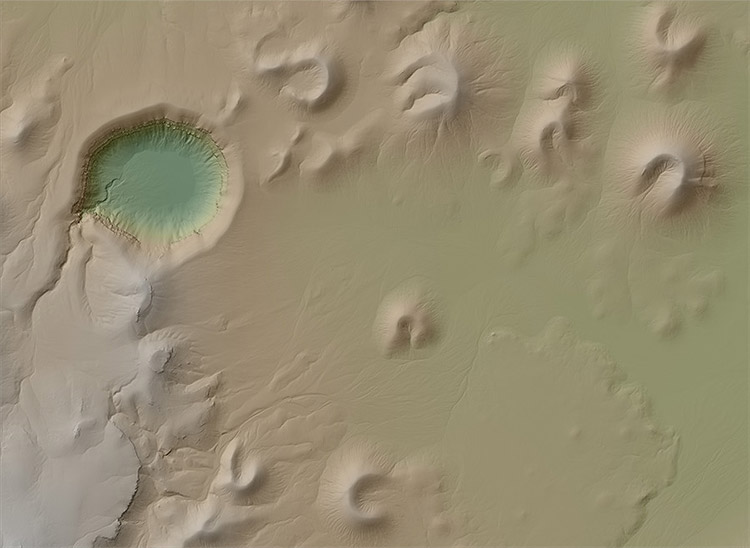National Science Foundation Renews Funding for OpenTopography
Science getaway for topographic data receives $1.365 million extension grant
Published Date
By:
- Warren Froelich
Share This:
Article Content

Image of the 430 foot-deep Lunar Crater and surrounding lava cones at the Lunar Crater National Natural Landmark, in central Nevada. High-resolution lidar topography data collected by the NSF-funded National Center for Airborne Laser Mapping for Greg Valentine, University at Buffalo.
The National Science Foundation (NSF) has renewed funding for OpenTopography, a science gateway that provides online access to Earth science oriented high-resolution topography data and processing tools.
The award, “Collaborative Research: OpenTopography -- A Cyberinfrastructure Facility for Topographic Data, Services, and Knowledge” from the NSF’s Division of Earth Sciences, provides $1.365 million during the next two and-a-half years for the third phase of the project (OT3) managed by the San Diego Supercomputer Center (SDSC) at UC San Diego; Arizona State University’s School of Earth and Space Exploration; and UNAVCO, a non-profit university-governed consortium facilitating geoscience research and education in Boulder, Colorado.
OpenTopography (OT) provides earth science-related, high-resolution topography to a large and varied user community advancing research and education in areas ranging from earthquake geology to ecology and hydrology. These data are essential for the study of the earth’s surface, its vegetation, and man-made structures.
OT3 will extend support for the community-focused data facility by strengthening interoperability, providing a broadened suite of processing and data services, adding new knowledge resources, and ensuring scalability via cloud and high-performance computing (HPC).
Since its launch in 2009, OT has seen a steady rise in data holdings from its partnerships and collaborations within the academic community and beyond. Over the past six years, the OT user community and processing jobs have grown substantially with the addition of new data and algorithms that produce higher-order products of interest to a wide range of users. These include the resource-intensive TauDEM algorithms for the extraction and analysis of hydrologic information from topography, running on the Gordon supercomputer based at SDSC. Gordon is part of the NSF’s eXtreme Science and Engineering Discovery Environment, the most advanced collection of integrated digital resources and services in the world that allows scientists to interactively share computing resources, data, and expertise.
“Expanding high-performance computing integration in OT3 ensures that the growing community demand for more compute-intensive algorithms and larger job sizes are met,” said Viswanath Nandigam, the project’s principal investigator and associate director for the Advanced Cyberinfrastructure Development group at SDSC. “Having OpenTopography based at SDSC, which houses Gordon as well as NSF’s most recent Comet petascale supercomputer, has the added advantage of leveraging a wide range of HPC expertise in-house.”
With the decreasing costs of high-resolution topography data collection, via methods such as structure from motion photogrammetry from unmanned aerial vehicles, rapid growth in new data is expected.
“We recognize that these ‘long-tail’ topography data (of modest size but great value) do not have a convenient home and that OT can play a key role in data management compliance and to enable reuse of these data by a broader Earth science community,” said Christopher Crosby, Geodetic Imaging manager at UNAVCO and OpenTopography co-investigator and project manager. OT3 will develop a workflow to enable community upload and ingestion of these data, including data validation and metadata extraction, before publishing the data via the Community Contributed Datasets page.
“In OT3, outreach and user support and engagement will remain strong with continued science community service, short courses, workforce development, and rich user community interaction,” said Ramon Arrowsmith, co-investigator for the project and an associate geology professor in ASU’s School of Earth and Space Exploration.
OT’s data catalog consists of 200 lidar (an acronym of light detection and ranging) point cloud datasets covering 184,327 km2 and 860 billion lidar returns. Aerial lidar is a surveying technology that creates dense measurements of the Earth’s surface using high pulse rate laser scanners. OT also provides access to NASA and the National Geospatial-Intelligence Agency’s Shuttle Radar Topography Mission global 1 and 3 arc second datasets, enabling topographic research around the globe.
Today, more than 12,400 users have created OT accounts, with numerous others using the system as guests; some 32,135 unique users have run more than 131,000 OT processing jobs. In addition, OT-enabled, peer-reviewed publications now exceed 200, spanning academic works in Earth science, ecology, hydrology, geospatial and computer science, and engineering.
Other SDSC researchers contributing to OpenTopography include software developers Minh Phan and Kai Lin.
Share This:
Stay in the Know
Keep up with all the latest from UC San Diego. Subscribe to the newsletter today.



